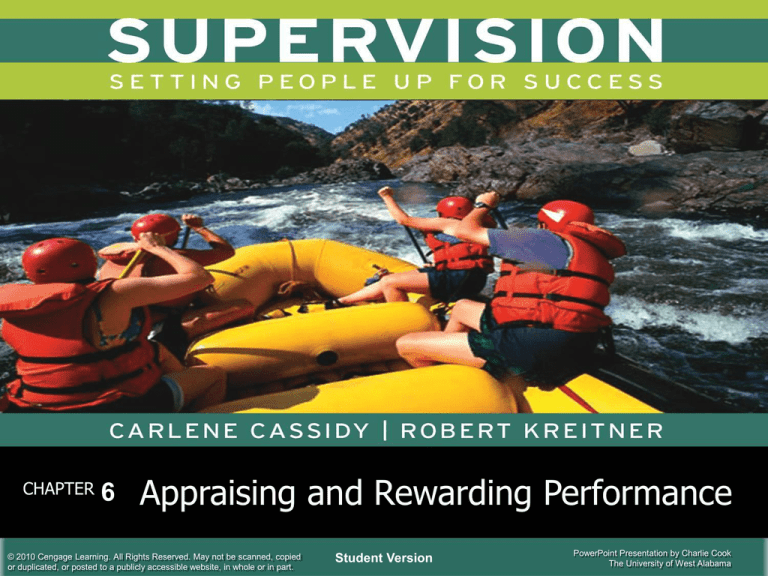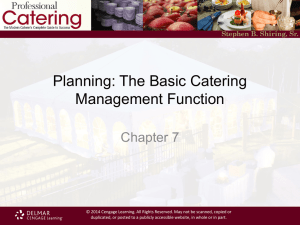
CHAPTER
6
Appraising and Rewarding Performance
© 2010 Cengage Learning. All Rights Reserved. May not be scanned, copied
or duplicated, or posted to a publicly accessible website, in whole or in part.
Student Version
PowerPoint Presentation by Charlie Cook
The University of West Alabama
Learning Objectives
1. Describe at least five performance appraisal techniques.
2. Explain what makes a performance appraisal legally
defensible and discuss the importance of record keeping
and confidentiality.
3. Explain how to design a performance appraisal system
and explain the value of including employees and
customers in the process.
4. Discuss performance measures and assessment criteria.
5. Discuss the “No Surprises” approach to supervision and
performance evaluations.
© 2010 Cengage Learning. All Rights Reserved. May not be scanned, copied
or duplicated, or posted to a publicly accessible website, in whole or in part.
6–2
Learning Objectives (cont’d)
6. Describe various types of employee compensation
plans; distinguish extrinsic rewards from intrinsic
rewards and list four rules for administering extrinsic
rewards effectively.
7. Compare individualized and team rewards and provide
examples of each.
© 2010 Cengage Learning. All Rights Reserved. May not be scanned, copied
or duplicated, or posted to a publicly accessible website, in whole or in part.
6–3
Performance Appraisal
• Cons
Appraisals can evoke strong negative emotions in
both the appraisers and the appraised.
Appraisals are perceived as a waste of time, a source
of lost productivity, and, if haphazard, a demotivator.
• Pros
Appraisals can be effective and satisfying if
systematically developed and implemented.
Appraisals can provide valuable feedback to
employees from their supervisors.
© 2010 Cengage Learning. All Rights Reserved. May not be scanned, copied
or duplicated, or posted to a publicly accessible website, in whole or in part.
6–4
Performance Appraisal (cont’d)
Goal Setting (MBO)
Weighted Check Lists
Written Essays
Rankings and
Comparisons
Performance
Appraisal
Techniques
Critical Incidents
Multirater Appraisal
Graphic Rating Scales
Continuous Improvement
Review (CIR)
© 2010 Cengage Learning. All Rights Reserved. May not be scanned, copied
or duplicated, or posted to a publicly accessible website, in whole or in part.
6–5
Mary recently met with her supervisor Nancy for her
annual performance appraisal. During the meeting,
Mary admitted that she had made a few mistakes
because she was rushing too much. She agreed to slow
down and check her work more thoroughly in an effort
to improve. Mary kept the conversation confidential and
did not mention it to anyone. The following week, one of
Mary’s coworkers said to her, “I hear you agreed to slow
down a little so you make fewer mistakes!” Of course,
Mary is left to assume that Nancy must have discussed
their conversation with others.
(Continued on next slide)
© 2010 Cengage Learning. All Rights Reserved. May not be scanned, copied
or duplicated, or posted to a publicly accessible website, in whole or in part.
6–6
1. How do you think Mary feels?
2. What impact do you think this will have on the
relationship between Mary and Nancy?
3. What do you suggest Nancy do to resolve this
situation?
© 2010 Cengage Learning. All Rights Reserved. May not be scanned, copied
or duplicated, or posted to a publicly accessible website, in whole or in part.
6–7
Making the Appraisal System Relevant
Employee
Input
Customer
Input
Cultural
Sensitivity
Performance
Appraisal Goal
Improving Productivity, Quality, and
Key Organizational Outcomes
© 2010 Cengage Learning. All Rights Reserved. May not be scanned, copied
or duplicated, or posted to a publicly accessible website, in whole or in part.
6–8
Performance Measures
• Performance Measures
Determine how an employee’s performance will be
evaluated.
• Types of Performance Measures
Quality Measures (How Good?)
Are measures of the level of excellence of a product or
service.
Quantitative Measures (How Many?)
Are quantifiable results, such as productivity.
© 2010 Cengage Learning. All Rights Reserved. May not be scanned, copied
or duplicated, or posted to a publicly accessible website, in whole or in part.
6–9
The previous section suggests that supervisors should
include a quality component to the performance evaluation
to measure both productivity as well as quality.
1. Do you agree or disagree with this recommendation?
Explain.
2. What are possible unintended consequences if a
supervisor measures only productivity (quantity)
without assessing quality?
3. What would happen if the supervisor evaluates only
quality without regard for productivity (quantity)?
© 2010 Cengage Learning. All Rights Reserved. May not be scanned, copied
or duplicated, or posted to a publicly accessible website, in whole or in part.
6–10
Assessment Criteria
• Assessment Criteria
Are the standards used to assess employee
performance.
• Effective Performance Criteria
Are based on standards for outcomes and behavior,
rather than on personal traits or characteristics.
Are consistent with the organization’s mission, values,
goals, and quality measures.
Assess both individual performance and individual
contributions to team, department, and organizational
objectives.
Are known and understood by employees.
© 2010 Cengage Learning. All Rights Reserved. May not be scanned, copied
or duplicated, or posted to a publicly accessible website, in whole or in part.
6–11
Performance Measures and
Assessment Criteria
Use of Quality and Quantitative
Measures
Choice of Individual and Group
Assessment Criteria
Performance
Measurement
Issues
Use of Weighted Elements and
Choice of Scale for Scoring
Setting the Frequency of
Performance Evaluation
Who to Select to Conduct the Appraisal
and Use of Self-Evaluation
© 2010 Cengage Learning. All Rights Reserved. May not be scanned, copied
or duplicated, or posted to a publicly accessible website, in whole or in part.
6–12
The “No Surprises” Approach to
Performance Appraisals and
Supervision
• Open, timely, honest, and shared forms of
communication are valued and expected part of
the firm’s culture.
Employees readily share bad news and other
information with supervisors.
Supervisors, in turn, share information and give fair
notice and warning of their actions to employees
(e.g., the timing and delivery of annual performance
appraisals).
© 2010 Cengage Learning. All Rights Reserved. May not be scanned, copied
or duplicated, or posted to a publicly accessible website, in whole or in part.
6–13
Employee Compensation and Rewards
• Rewards
Are defined broadly as the material and psychological
payoffs for performing tasks in the workplace.
Can, when properly administered, improve job
performance and satisfaction.
• Types of Rewards
Extrinsic rewards are given to individuals by others.
Pay raises, benefits, promotions, praise
Intrinsic rewards are self-granted rewards with
internally experienced payoffs
Accomplishment, self-esteem, and self-actualization
© 2010 Cengage Learning. All Rights Reserved. May not be scanned, copied
or duplicated, or posted to a publicly accessible website, in whole or in part.
6–14
Employee Compensation Plans
• Importance of Compensation
It is perceived as a universal motivator.
It is two-thirds of total business expenses.
It has significant legal and tax implications for the
firm.
It’s becoming more flexible and variable to meet the
needs of employers and the demands of a more
diverse work force.
© 2010 Cengage Learning. All Rights Reserved. May not be scanned, copied
or duplicated, or posted to a publicly accessible website, in whole or in part.
6–15
Consider the following story from the airline industry, then answer
the questions that follow.
Something funny is happening in the aviation industry: Airlines are making
money again. But while that’s good news for shareholders, it’s infuriating
pilots and other employees who took pay cuts in the wake of 9/11.
Nowhere are pilots as peeved as they are at American, where the airline’s
12,000-member Allied Pilots Association has declared war on
management.
The pilots’ chief complaint: Four years after they voluntarily gave up 23%
of their pay along with other concessions to help stave off bankruptcy, top
executives of American and parent AMR Corp. have received about a
quarter-billion dollars in AMR stock, while employees got only small pay
increases. With American poised to have one of its best years ever, its
pilots say they just want to make the same as they did in 1992, adjusted
for inflation. (Continued on next slide)
© 2010 Cengage Learning. All Rights Reserved. May not be scanned, copied
or duplicated, or posted to a publicly accessible website, in whole or in part.
6–16
1. One of American Airline’s executives made this
statement about the pilots’ complaints:
“Our strategic decisions kept the company out of
bankruptcy and we deserve to be rewarded for it.”
How would you respond to this statement?
2. From an employee motivation standpoint, what role
does reward equity play in this situation?
© 2010 Cengage Learning. All Rights Reserved. May not be scanned, copied
or duplicated, or posted to a publicly accessible website, in whole or in part.
6–17
Team-Based Versus Individualized
Rewards
• Team Rewards
Rewards given to a group of employees to recognize
team-based goal attainment.
• Resistance to Team Rewards
Concept of team rewards goes against the grain of an
individualistic culture.
Poorly conceived and administered plans have given
team-based pay a bad reputation.
© 2010 Cengage Learning. All Rights Reserved. May not be scanned, copied
or duplicated, or posted to a publicly accessible website, in whole or in part.
6–18
Consider the following quotes from a recent article on work/life
balance, then answer the questions that follow.
Employees are looking for more than a paycheck in today’s
competitive work environment.
Striking a balance between work and family life is a top priority,
according to a recent survey. . . .
It indicated that more than half of respondents cited flexibility as
“very important” to overall job satisfaction.
If you want to keep some of your most valuable players, it may be
time to consider instituting family-friendly policies such as flex-time
and telecommuting, human-resources experts say.
(Continued on next slide)
© 2010 Cengage Learning. All Rights Reserved. May not be scanned, copied
or duplicated, or posted to a publicly accessible website, in whole or in part.
6–19
1. How do you plan to achieve work/life balance in your
career?
2. Which is more important to you, more pay or more
leisure time? Explain.
3. From a supervisor’s perspective, what are the pros
and cons of fl ex-time and telecommuting?
© 2010 Cengage Learning. All Rights Reserved. May not be scanned, copied
or duplicated, or posted to a publicly accessible website, in whole or in part.
6–20
TERMS TO UNDERSTAND
360-degree review
assessment criteria
behaviorally anchored rates scales (BARS)
cafeteria compensation
confidentiality
continuous improvement review (CIR)
equitable
extrinsic rewards
individualized rewards
intrinsic rewards
performance measures
quality measures
quantitative measures
rewards
self-evaluation
team rewards
© 2010 Cengage Learning. All Rights Reserved. May not be scanned, copied
or duplicated, or posted to a publicly accessible website, in whole or in part.
6–21








